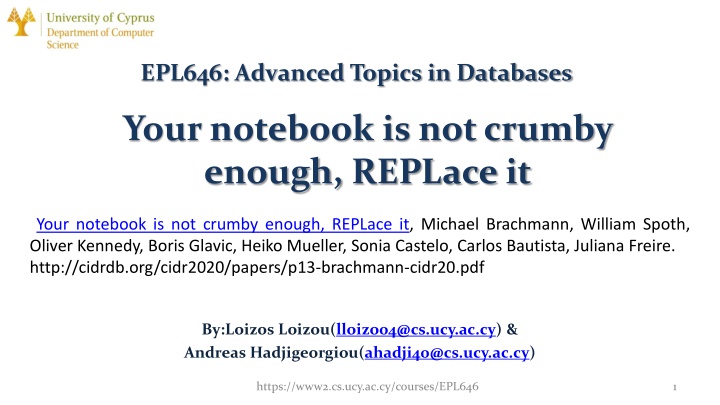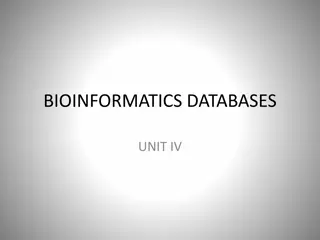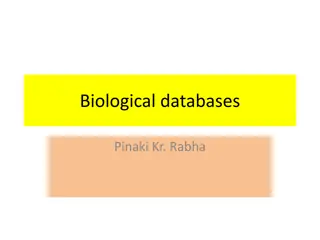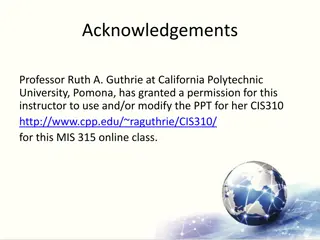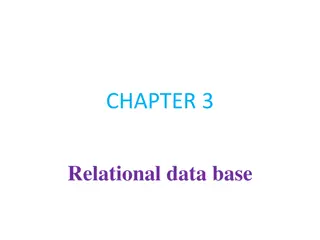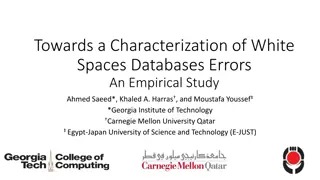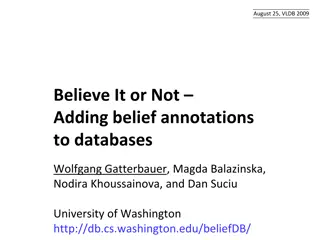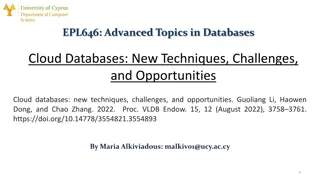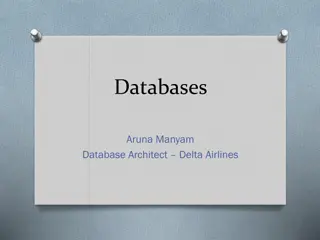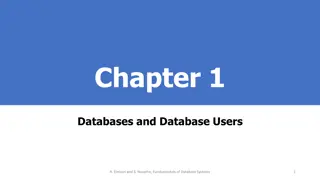Advanced Topics in Databases: Vizier Overview and Limitations of Existing Tools
Advanced Topics in Databases cover a range of subjects including Vizier, an open-source data pipeline tool, and the limitations of existing tools, such as reproducibility and error tracking in REPL-based notebooks. Vizier combines the flexibility of notebooks with a spreadsheet-like interface, offering provenance tracking and data caveat detection. Explore how Vizier aims to address the issues faced by traditional tools through its design and requirements, enforcing in-order execution and supporting big data workflows.
Download Presentation

Please find below an Image/Link to download the presentation.
The content on the website is provided AS IS for your information and personal use only. It may not be sold, licensed, or shared on other websites without obtaining consent from the author.If you encounter any issues during the download, it is possible that the publisher has removed the file from their server.
You are allowed to download the files provided on this website for personal or commercial use, subject to the condition that they are used lawfully. All files are the property of their respective owners.
The content on the website is provided AS IS for your information and personal use only. It may not be sold, licensed, or shared on other websites without obtaining consent from the author.
E N D
Presentation Transcript
EPL646: Advanced Topics in Databases Your notebook is not crumby enough, REPLace it Your notebook is not crumby enough, REPLace it, Michael Brachmann, William Spoth, Oliver Kennedy, Boris Glavic, Heiko Mueller, Sonia Castelo, Carlos Bautista, Juliana Freire. http://cidrdb.org/cidr2020/papers/p13-brachmann-cidr20.pdf By:Loizos Loizou(lloizo04@cs.ucy.ac.cy) & Andreas Hadjigeorgiou(ahadji40@cs.ucy.ac.cy) 1 https://www2.cs.ucy.ac.cy/courses/EPL646
Vizier Overview Vizier is an open-source tool that helps analyst to build and refine data pipelines. It combines the flexibility of notebooks with the easy-to-use data manipulation interface of spreadsheets. Advanced provenance tracking for both data and computational steps. Exposes potential issues with data refer to as data caveats.
Limitation of Existing Tools Most existing tools are REPLs-based notebooks but this models leads to limitations with: Reproducibility Direct Manipulation Versioning and Sharing Uncertainty and Error Tracking
Problem of REPLs-based Notebooks The REPL-based notebooks are stateful Every state managed by the REPL https://www.cs.ucy.ac.cy/courses/EPL646 4
Trail of Breadcrumbs Common use of notebooks Pros Produce new data Intermediate states Other usage of notebook Cons Manual work from user
Vizier Design Designed to encourage reproducibility Don t use REPL s model 6
Requirements Designing Vizier Enforcing in-order execution. Workflow-style execution. Fine-grained provenance. Big data support. https://www.cs.ucy.ac.cy/courses/EPL646 7
Vizier Notebook Similar to other notebooks, Jupyter and Apache Zeppelin. An analytics workflow is broken down into individual steps called Cells. In order workflow cells Vizier s two core components : Workflow & Dataflow manager
Workflow & Dataflow Workflow Cells Dataflow Cells 1. Compiled to SQL queries 1. Read dataset 2. Views 2. Checkpoint dataset 3. Create dataset https://www.cs.ucy.ac.cy/courses/EPL646 9
Viziers Version Models Vizier is versioning: 1. The notebook 2. The states 3. The cells Note: Figure 4 illustrates the branching version history https://www.cs.ucy.ac.cy/courses/EPL646 10
Viziers Dependency Model Vizier manages two graphs of dependencies: 1. Workflow dependencies 2. Dataflow dependencies
Viziers Execution Model As we mentioned before Vizier has two core components : 1. Workflow manager 2. Dataflow manager
Workflow Manager Workflow manager is responsible for: 1. Managing Cells 2. Inter-Cell Dependencies 3. Scheduling Workflow Cell Execution 4. The version history
Dataflow Manager Dataflow Manager is responsible for: 1. Storing and mediating access to dataset versions 2. Propagating caveats 3. Fine-grained provenance analysis https://www.cs.ucy.ac.cy/courses/EPL646 14
Viziers User Interface Vizier User s Interface consist of four main views: 1. The Notebook view 2. The Spreadsheet view 3. The Caveat view 4. The History view https://www.cs.ucy.ac.cy/courses/EPL646 15
Viziers User Interface https://www.cs.ucy.ac.cy/courses/EPL646 16
Spreadsheet Operations Spreadsheet edits must be reflected in the notebook Vizier Supports a range of cell types based on a language for spreadsheet-style operations called Vizual Vizual is responsible to model user actions on a spreadsheet Challenges Viziers had to overcome was: 1. Data types in Spreadsheets 2. Declarative Updates 3. Row Identity https://www.cs.ucy.ac.cy/courses/EPL646 17
Spreadsheet Data Types Vizier s datasets are using a stronger relational data model than the lightweight interface used by typical spreadsheets. 1. Vizier assumes that user s actions are intentional for that reason it allows column types to be escalated so that the newly entered value to represented as-is. 2. Vizier relies on the column type to resolve the ambiguity that is occurring in the spreadsheets. https://www.cs.ucy.ac.cy/courses/EPL646 18
Declarative Updates Vizier has build a technique called reenactment which translates sequences of DML operations into equivalent queries. This technique was built to preserve the versioning in Vizier. The user s actions in the spreadsheet are added as vizual cells to the notebook. And these vizual operations are translated automatically into SQL DDL/DML expressions. https://www.cs.ucy.ac.cy/courses/EPL646 19
Row Identity Vizier in order to deal with such updates and to be able to represent unordered relational data as a spreadsheet, it needed to maintain a mapping between rows and their positions in the spreadsheet. Since Vizier recorded both the position of a row and a unique stable identifier for it, Vizier can ensure that a Vizual operation always applies to the same cell. For derived data, Vizier uses a row identity model based on GProM s encoding of provenance. Derived rows, such as those produced by declaratively specified table updates, are identified as follows: 1. Rows in the output of a projection or selection use the identifier of the source row that produced them 2. Rows in the output of a UNION ALL are identified by the identifier of the source row and an identifier marking which side of the union the row came from 3. Rows in the output of a cross product or join are identified by combining identifiers from the source rows that produced them into a single identifier 4. Rows in the output of an aggregate are identified by each row s group-by attribute values. Base case: datasets loaded into Vizier or created through the workflow API. We considered three approaches for identifying rows in raw data: order-, hash-, and key-based. None of. Our prototype implementation combines the first two ordering and hashing to preserve associativity and commutativity during optimization, union-handedness is recorded during parsing proaches: deriving identifiers from both sequence and hash code. https://www.cs.ucy.ac.cy/courses/EPL646 20
Caveat An annotation that applied on a cell or a row of the dataset Indicates that a cell value or a row is potentially suspect or uncertain Consist of a human readable description Originally introduced as uncertain values https://www.cs.ucy.ac.cy/courses/EPL646 21
Managing Caveats Management of caveats is one of the core functionalities of Vizier. Vizier steps for managing caveats Applying Caveats Propagating Caveats https://www.cs.ucy.ac.cy/courses/EPL646 22
Applying Data Caveats - Vizier expose a function from the dataflow layer caveat(id, value, message) - Caveats applied when a dataset is uploaded. - Use of caveats to annotate data - String Parsing - CSV Parsing https://www.cs.ucy.ac.cy/courses/EPL646 23
Propagating Caveats General annotation management systems let the user decide how an annotation propagate. Vizier propagate caveats only if the value affect the output https://www.cs.ucy.ac.cy/courses/EPL646 24
Propagating Caveats Vizier splits propagation of caveats into two parts for limiting overhead Instrumenting Queries Computing Caveat Details https://www.cs.ucy.ac.cy/courses/EPL646 25
